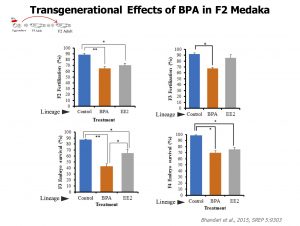Research
Transgenerational Inheritance of Environmentally Induced Health Effects
The window of early embryonic development is susceptible to environmental chemical stressors. Exposures during gonadal sex determination may lead to reproductive defects in adulthood. These effects can be transgenerationally transmitted to subsequent generations via the germline (sperm and eggs). Transgenerational effects appear in individuals, not because of direct exposure but due to ancestral exposure, and have been  thought to be contributing to declining reproductive fitness and the emergence of endangered species in natural populations. We are studying molecular alterations occurring during the transgenerational inheritance of phenotypes to identify chemical and phenotype-specific biomarkers associated with adverse reproductive outcomes using medaka fish (d-rR medaka, Oryzias latipes) as a model organism. We anticipate the biomarkers to be reliably predictive of the history of exposure and associated transgenerational phenotypes.
thought to be contributing to declining reproductive fitness and the emergence of endangered species in natural populations. We are studying molecular alterations occurring during the transgenerational inheritance of phenotypes to identify chemical and phenotype-specific biomarkers associated with adverse reproductive outcomes using medaka fish (d-rR medaka, Oryzias latipes) as a model organism. We anticipate the biomarkers to be reliably predictive of the history of exposure and associated transgenerational phenotypes.
” In model organisms and humans, studies have shown that nutritional restriction or exposure to hormone-mimicking chemicals during early gestation cause alterations in adult and offspring health across several generations”. The picture below shows the molecular signatures established by direct exposure may be translated into adverse health outcomes in the exposed individual or may not be expressed at all.

Fig. Environmentally induced phenotypes in humans and fish.
However, studies have shown that such direct effects may remain latent for quite a long time and emerge as multiple adverse health outcomes in individuals in subsequent generations. In humans, it is difficult to study such effects directly. Studies in animal models may provide important insights into the mechanisms underlying such effects. We are developing a comparative model using mice and fish as organismal models to identify conserved mechanisms that are specific to environmental stressors and adverse health phenotypes.

Fig. An example of transgenerational phenotype in fish, especially for exposure occurring during early embryonic development.
Related publications
- Chakraborty, S., Dissanayake, M., Godwin, J., Wang, X., Bhandari, R.K. (2022). Ancestral BPA exposure caused defects in the liver of medaka for four generations. Science of the Total Environment.856(1):159067
- Cleary, J.C., Tillitt, D.E., vom Saal, F.S., Nicks, D.K., Claunch, R.A, Bhandari, R.K. (2019). Transgenerational effects of developmental Atrazine exposure on the reproductive axis of medaka. Environmental Pollution, 251: 631-650. [PMID: 31108297]
- Wang, X., Hill, D., Tillitt, D.E., Bhandari, R.K (2019). Bisphenol A and 17alpha-ethinylestradiol induced transgenerational differences in the expression of osmoregulatory genes in the gill of medaka (Oryzias latipes). Aquatic Toxicology. 211: 227-234. [PMID: 31048106]
- Bhandari, R.K. (2016). Medaka as a model for studying environmentally induced transgenerational inheritance phenotypes.Environmental Epigenetics 2:1-9. (Invited perspective) [PMID: 29492282]
- Bhandari R.K., vom Saal, F.S., Tillitt, D. E. (2015). Transgenerational effects from early developmental exposures to bisphenol A or 17α-ethinylestradiol in medaka, Oryzias latipes. Scientific Reports, 5 : 9303. [PMID: 25790734]
- Skinner MK, Guerrero-Bosagna C, Haque M, Nilsson E, Bhandari RK, McCarrey JR (2013) Environmentally induced transgenerational epigenetic reprogramming of primordial germ cells and the subsequent germline. PLoS One. 8(7):e66318. [PMID: 23869203]





